Our indexes include entries for the spelling becket. In the period you have requested, we have the following 223 records (displaying 131 to 140):
Hertfordshire Sessions
(1752-1799)
Incidents from the Hertfordshire Sessions Books and Minute Books. These cover a wide range of criminal and civil business for the county: numerically, the most cases (362) concerned assaults and rioting, and larceny (378), but there is a large variety of other matter, as extensive as the jurisdiction of the courts. These highly condensed abstracts of the entries were prepared by William le Hardy, and published for the County Council in 1935. | Sample scan, click to enlarge
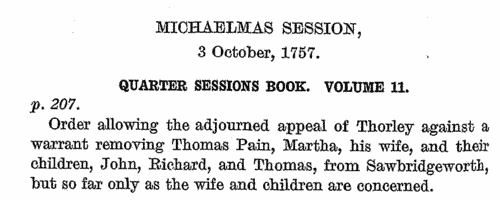
|
 Apprentices registered in Scotland
(1802) Apprentices registered in Scotland
(1802)
Apprenticeship indentures and clerks' articles were subject to a 6d or 12d per pound stamp duty: the registers of the payments usually give the master's trade, address, and occupation, and the apprentice's name, as well as details of the date and length of the apprenticeship. There are central registers for collections of the stamp duty in London, as well as returns from collectors in the provinces. These collectors generally received duty just from their own county, but sometimes from further afield. The indentures themselves can date from a year or two earlier than this return. (The sample entry shown on this scan is taken from a Bristol return. Each entry has two scans, the other being the facing page with the details of the indenture, length of service, and payment of duty.) IR 1/70 | Sample scan, click to enlarge
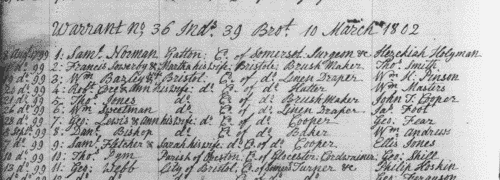
|
Inhabitants of London
(1805)
Holden's Triennial Directory for 1805 to 1807 includes this 'London Alphabet. Private Residences'. About 10,000 people are recorded. | Sample scan, click to enlarge
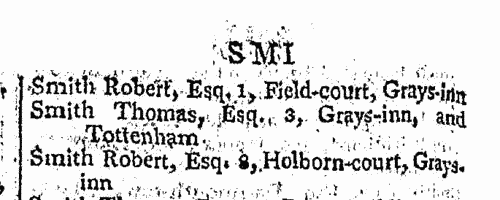
|
Inhabitants of The Potteries, in Staffordshire
(1805)
Holden's Triennial Directory of 1805 to 1807 included a provincial section, listing professional people and traders in England, Wales, Scotland and Ireland. (The sample scan here is from the listing for Bath) | Sample scan, click to enlarge
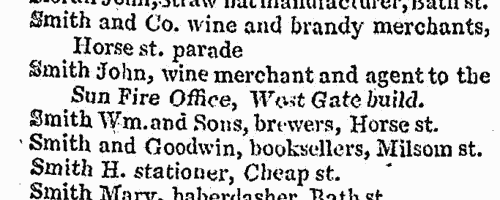
|
The Duke of Clarence's household
(1805)
His Royal Highness prince William Henry, third son of his Majesty king George III, was created Duke of Clarence in 1789. On the death of his eldest brother, George IV, 26 June 1830, the duke succeeded to the throne as king William IV, George III's second son (Frederick duke of York) having died childless in 1827. Officers of the duke's household are listed in Holden's Triennial Directory of 1805 to 1807. | Sample scan, click to enlarge

|
The Duke of Cumberland's household
(1805)
His Royal Highness prince Ernest Augustus, fifth son of his Majesty king George III, was born 5 June 1771, and created Duke of Cumberland and Teviotdale and Earl of Armagh in 1799. His official seat was at Kew Green, his town residence being at Ambassador's Court, St James's. Officials of his household are listed in Holden's Triennial Directory of 1805 to 1807. | Sample scan, click to enlarge

|
The Duke of Sussex's household
(1805)
His Royal Highness prince Augustus Frederick, born in 1773 sixth son of his Majesty king George III, was created Duke of Sussex, Earl of Inverness and Baron Arklow in 1801. He resided at Kensington Palace. Officials of his household are listed in Holden's Triennial Directory of 1805 to 1807. | Sample scan, click to enlarge

|
The household of the Prince of Wales
(1805)
His Royal Highness prince George, born in 1762, eldest son of his Majesty king George III, was Prince of Wales. At the death of his father in 1820, he succeeded to the throne as king George IV. Officials of his household are listed in Holden's Triennial Directory of 1805 to 1807. | Sample scan, click to enlarge

|
Traders and professionals in London
(1805)
Holden's Triennial Directory for 1805 to 1807 includes this 'London Alphabet of Businesses, Professions, &c.': coverage is good; about 30,000 individuals are recorded. | Sample scan, click to enlarge

|
Bankrupts
(1786-1806)
William Smith's abstracts of bankrupts, dividends and certificates for England and Wales from 1786 to June 1806. Bankruptcy causes abrupt changes in people's lives, and is often the reason for someone appearing suddenly in a different location or in a different occupation. | Sample scan, click to enlarge
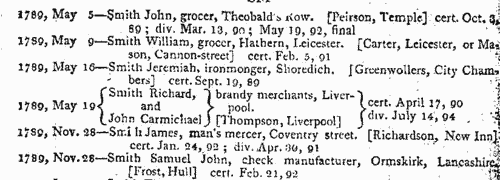
|
Research your ancestry, family history, genealogy and one-name study by direct access to original records and archives indexed by surname.












